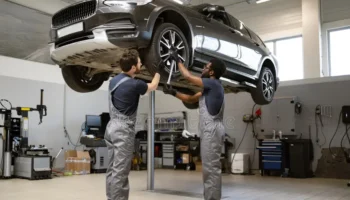Flooding is one of the most destructive natural events that can happen to vehicles. Even a few inches of standing water can cause significant mechanical and electrical damage that may not be immediately visible. When a car has been submerged or exposed to floodwater, professional attention is essential to prevent long-term problems and safety hazards. A skilled auto repair shop has the tools, diagnostic equipment, and expertise to inspect, clean, and restore flood-damaged vehicles properly. Understanding how professionals handle such cases can help car owners make smarter decisions after a flood.
Understanding Flood Damage in Vehicles
Flood damage can affect every part of a vehicle, from the exterior body panels to sensitive electronics. Unlike other forms of car damage, flood-related issues are often hidden beneath the surface. Moisture seeps into wiring, insulation, mechanical components, and even the interior cabin, leading to corrosion, short circuits, and performance issues that develop over time.
When water enters a vehicle, its impact depends on the level of submersion and the type of water involved. Clean rainwater is less corrosive than saltwater or sewage-contaminated floodwater, which can cause severe chemical and biological contamination. Regardless of the type, any vehicle exposed to flooding requires immediate professional inspection to assess damage and determine repair viability.
Why You Should Never Ignore Flood Damage
Ignoring flood damage may seem tempting if the vehicle appears to run normally afterward. However, trapped moisture and contaminants often cause delayed failures. Electrical systems, in particular, may seem functional initially but fail unexpectedly weeks or months later. Corrosion on connectors and sensors spreads quickly, damaging costly components like the engine control unit (ECU) or transmission modules.
Additionally, water inside the cabin can lead to mold growth, unpleasant odors, and health risks for passengers. A professional auto repair shop understands these risks and performs detailed diagnostics to identify both visible and hidden damage before making repair recommendations.
Step-by-Step Process Auto Repair Shops Use for Flood-Damaged Cars
Repairing a flood-damaged vehicle is not a single-step process. It involves systematic inspection, drying, cleaning, and component testing to ensure complete restoration.
1. Initial Inspection and Damage Assessment
Before any repairs begin, technicians perform a thorough inspection to determine the extent of the damage. This process typically includes:
- Visual examination: Checking for mud, silt, or water residue inside the engine bay, under seats, and within the trunk area.
- Water line identification: Determining how high the water reached on the body and interior surfaces.
- Fluid sampling: Inspecting engine oil, transmission fluid, and brake fluid for signs of contamination. Milky or foamy fluids indicate water intrusion.
- Electrical system check: Assessing fuse boxes, relays, and connectors for corrosion or water exposure.
- Structural evaluation: Looking for rust or warping on the chassis and suspension components.
Once the assessment is complete, the repair shop provides an estimate of repair costs and determines whether the car is salvageable or requires extensive restoration.
2. Battery and Electrical System Disconnection
The next critical step is disconnecting the battery to prevent electrical shorts. Floodwater often creates conductive pathways between circuits, which can cause fires or irreversible damage to control modules. Technicians disconnect the power source before drying and cleaning to ensure safety during repairs.
3. Drying the Vehicle Thoroughly
Drying is one of the most time-sensitive aspects of flood recovery. The longer water remains trapped in a vehicle, the more extensive the corrosion and mold growth become.
Methods used by auto repair shops include:
- Industrial drying fans and dehumidifiers: These remove moisture from the cabin and mechanical compartments.
- Vacuum extraction: Technicians use specialized vacuums to remove standing water from carpets and seats.
- Heated air circulation: Controlled heating accelerates evaporation without damaging sensitive materials.
- Disassembly of interior components: Seats, carpeting, and door panels are removed to dry hidden areas completely.
Flood recovery isn’t just about drying what’s visible; technicians focus on ensuring no trapped moisture remains under the flooring, insulation, or dashboard.
4. Cleaning and Disinfecting Interior Components
Floodwater carries contaminants like dirt, oil, and bacteria. Therefore, professional cleaning is essential to restore the car’s hygiene and prevent mold development.
Auto repair shops typically:
- Use antimicrobial cleaning agents to sanitize carpets and upholstery.
- Replace air filters and cabin filters to eliminate odors and moisture buildup.
- Clean HVAC ducts and vents to prevent mold spores from circulating.
- Replace any saturated insulation or soundproofing material.
Professional-grade steam cleaning and ozone treatments are also used to remove persistent smells and ensure a clean interior environment.
5. Fluid Replacement and Engine System Flushing
Water contamination in mechanical fluids can cause catastrophic engine or transmission failure. Even minimal moisture can compromise lubrication and create internal rust.
Technicians address this by:
- Draining and replacing all major fluids, including engine oil, transmission fluid, coolant, power steering fluid, and brake fluid.
- Cleaning the oil pan and filter housing to remove water and debris.
- Flushing the fuel system if water entered through the gas tank or vent lines.
- Inspecting spark plugs, injectors, and intake components for moisture or sediment.
If the engine was submerged, a compression test and cylinder inspection are often performed to detect internal water damage.
6. Electrical and Computer Diagnostic Testing
Modern vehicles depend heavily on electronic systems for performance and safety. After flood exposure, even minor corrosion on a connector can cause erratic behavior.
Auto repair shops perform:
- OBD-II scanning: Detects any fault codes from sensors, modules, or control units.
- Voltage and continuity testing: Ensures electrical circuits remain intact and grounded correctly.
- Component replacement: Damaged wiring harnesses, fuse boxes, or sensors are replaced as needed.
In some cases, the entire vehicle control system (ECU, transmission control module, etc.) may need reprogramming or replacement if exposed to significant water damage.
7. Brake and Suspension System Inspection
Flooding can severely affect braking performance. Water exposure corrodes brake lines, pads, and rotors, leading to reduced stopping power.
Technicians check:
- Brake pads and rotors for rust and contamination.
- Brake fluid for water infiltration.
- Suspension bushings and joints for corrosion.
- Wheel bearings for trapped moisture or debris.
If any component shows signs of wear or oxidation, it is replaced to maintain proper handling and safety.
8. Exterior and Undercarriage Care
The undercarriage is highly vulnerable to rust and sediment buildup after a flood. Mud and saltwater often cling to metal surfaces, accelerating corrosion.
Professional repair includes:
- Power washing the undercarriage and frame.
- Applying anti-rust coatings or sealants to protect against future corrosion.
- Inspecting exhaust pipes, fuel lines, and drivetrain components for contamination.
By restoring and protecting these areas, auto repair shops prevent long-term deterioration that might otherwise compromise the vehicle’s structure.
9. Final Inspection and Testing
After repairs and cleaning, a comprehensive inspection ensures that all systems function correctly. This includes:
- Road testing the vehicle under various conditions.
- Checking for fluid leaks, electrical faults, or unusual noises.
- Verifying that air conditioning, lights, and sensors work properly.
Only after the vehicle passes all performance and safety tests is it considered ready for use.
When a Flood-Damaged Car May Be Beyond Repair
Not all flood-damaged vehicles can be safely repaired. If water has reached critical components like the engine intake, transmission, or electronic control units, repairs may exceed the vehicle’s value. In such cases, auto repair professionals typically recommend a total loss evaluation. Attempting to restore a severely submerged car without professional input can lead to ongoing mechanical failures, reduced safety, and costly future repairs.
Preventing Future Flood Damage
While floods are often unpredictable, there are steps drivers can take to reduce potential damage:
- Avoid driving through flooded roads: Even shallow water can stall the engine or flood the interior.
- Park on higher ground: During storms or heavy rain, choose elevated parking areas away from drainage zones.
- Regular undercarriage cleaning: Removes accumulated dirt and salt that promote corrosion.
- Seal maintenance: Ensure door and trunk seals remain intact to prevent water leaks.
- Install weatherproof floor mats: These help protect carpets from moisture and mud during rainy seasons.
Professional advice from an auto repair shop can also help identify additional preventive measures tailored to your vehicle and region.
FAQs
Q1: Can I start my car after it has been flooded?
No. Starting a flood-damaged vehicle can pull water into the engine, causing hydro-locking and irreversible damage. Always have a professional inspect it first.
Q2: How can I tell if my car has hidden flood damage?
Look for signs like musty odors, fogged headlights, damp carpets, rust under seats, or malfunctioning electronics. A technician can confirm using diagnostic tools.
Q3: Will insurance cover flood-related repairs?
If you have comprehensive coverage, insurance usually covers flood damage. However, repair shops can provide documentation to assist in claim processing.
Q4: How long does it take to repair a flood-damaged car?
Repair time varies based on severity but typically ranges from several days to a few weeks. Extensive electronic replacements or mold remediation can extend timelines.
Q5: Are flood-damaged cars safe to drive after repair?
Yes, provided that all affected systems have been professionally inspected, cleaned, and replaced where necessary. Post-repair testing ensures full safety compliance.
Q6: Can saltwater damage be repaired the same way as freshwater damage?
Saltwater is far more corrosive and requires aggressive cleaning, decontamination, and part replacement. Professional inspection is essential to prevent long-term corrosion.
Q7: How often should flood-exposed vehicles be re-inspected?
After the initial repair, it’s wise to schedule a follow-up inspection within 30 to 60 days to ensure that corrosion or moisture hasn’t reappeared.
When your vehicle has faced flooding, trusting a professional auto repair shop is the safest and most effective choice. Expert technicians can identify the true extent of damage, replace compromised parts, and restore your car to reliable condition—protecting both your investment and your peace of mind.





